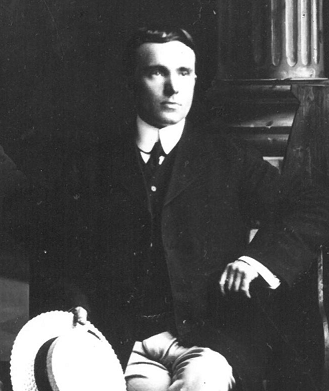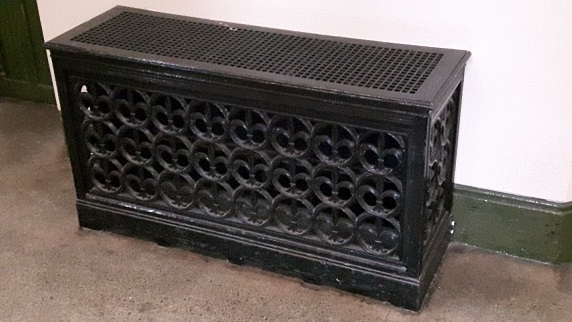Graduation and Gridding
With Graduation Week nearly upon us it offers us a good opportunity to look back at the early days of graduation at Aberystwyth.
Until 1893, when the colleges of Aberystwyth, Bangor and Cardiff were formed into The University of Wales, Aberystwyth students sat the examinations of the University of London, but following the granting of the Royal Charter the new university could award its own degrees. The first major graduation ceremony that was held afterwards was at Aberystwyth on 26 June 1896, when Prince Albert, the Prince of Wales, was installed as Chancellor of the University of Wales. The installation ceremony itself was held in a marquee specially erected in front of the Town Hall, but Aberystwyth took full advantage of the Royal visit and of its new powers by awarding a Doctorate of Law on the Prince; a Doctorate in Music on his wife, Princess Alexandra, and a Doctorate of Law on the Prime Minister William Ewart Gladstone who had accompanied them to Aberystwyth. This ceremony was held at the newly completed Pier Pavilion which had been opened by the princess herself, naming it the Royal Pier Pavilion. The last duty of the royal party was at 4.30pm when the Princess of Wales opened the newly completed women’s hall of residence, Alexandra Hall.
As this was the first degree awarding ceremony of the University of Wales, a number of things had to be created from scratch, not least the ceremonial robes, as was reported in The Cambrian News:
The Welsh Hoods
For the first time in the history of Wales, or even of Cymru, the hoods of the Welsh degree were to be seen mingling with the hoods of the ancient Universities; Cambria, coming late into the family of education, found all the primary colours selected to make university hoods distinctive, but Lady Verney came to the rescue and suggested silks shot with different colours which were very effective. At the ceremony Mr Gladstone wore the robe of doctor of law of the University of Wales—a scarlet robe with hanging sleeves, faced and the sleeves lined with a silk shot with blue and red. The hood was of scarlet cloth lined with silk of the same colour an ordinary academic cap covered with velvet...The Princess of Wales wore the full robes of a doctor of music of the Welsh University that is to say, a scarlet robe with hanging sleeves, faced, and the sleeves lined with pearl-coloured silk shot with three hues; the pearl-coloured silk being set upon a border of deep blue. The hood of deep blue was lined with pearl silk, and the cap, of the ordinary academic shape, was covered with velvet with a gold tassel, indicating the dignity of the recipient of the degree.
The Chancellor's robe (the Prince of Wales') has been made by Ede and Son of Chancery Lane. It is made of the finest black satin figured damask covered with gold lace and looped...In the gold ornaments of the Chancellor's robe the Welsh dragon is introduced five times. The academic cap of the usual shape was covered with velvet lace with gold and having a gold tassel. The Deputy Chancellor's robes were plain academic of corded silk with puffed sleeves, looped up with loops of twisted gold cord a cap covered with velvet and with one band of gold. The Vice-chancellor wore a robe of scarlet cloth lined, with a deeper shade of scarlet, a hood of scarlet cloth lined with ermine. The Treasurer's robe was similar to the Deputy Chancellor's, but with more gold ornament. The Warden of the Guild wore a black grown with blue black velvet sleeves similar to a proctor's gown at Oxford. The Registrar wore a gown, similar to the Deputy Chancellor's but braided with black and the sleeves looped up by black cord. (The Cambrian News 3 July 1896)
Representatives from the colleges at Bangor and Cardiff were also present on the day. The Cardiff contingent would have preferred that the ceremony had been held in Cardiff, and had argued their case at length, but as Aberystwyth was the mother College it had been decided that it was only proper that the installation ceremony of the first Chancellor of the University of Wales was held at Aberystwyth.
And the officers of the colleges of Bangor and Cardiff – along with their graduating students – would have to make the journey to Aberystwyth an annual one for the next six years as the University of Wales graduation ceremony would be held in the town until 1901.
These visits by the younger institutions was always a matter of pride and joy to Aberystwyth students, and the aftermath of the 1901 ceremony, that was held at the Royal Pier Pavilion on Friday 15 November, appears to have been an especially joyous occasion, as Professor Thomas A. Levi recalled:


On the next day there were extraordinary scenes at the College. As I was making my way down Pier Street and King Street towards the College, I noticed a suspicious crowd of students walking aside of me to the College. By the time I reached the College door they hoisted me to their shoulders and bore me to the gridiron in the Quad.
Before T.A. Levi continues with his reminiscences, maybe I should explain what he meant by ‘gridiron’ and the significance that they played in College activities at the time. It has nothing to do with American football, but rather refers to the iron railings that cover the two large radiators that are prominent fixtures in the Quad.

This is how a Student’s Handbook of the time refers to the traditions that surround them:
No account of life in the "Quad." would be complete without reference to the time-honoured custom of "Gridding." The student is nothing unless appreciative, and next to achieving distinction himself, he revels in the success of another, and always hails with unalloyed delight the crowned victor from the arena of learning. "Gridding" is the sincere, albeit somewhat boisterous, expression of that sentiment, and it is not the least interesting episode in the annals of the Quadrangle when the happy (sic) hero is bundled unceremoniously on to the "Grid," and expresses his happiness (sic) therefrom to the delectation of the noisy rabble below.
And onto the gridiron Professor Levi was placed, along with others:
On the gridiron already were Professor Sudborough (Professor of Chemistry) and Mr. Hibbert. And we all had to make speeches of some sort. There is no exaggeration in saying the students were there from about ten till three in the afternoon. They insisted on hoisting every person connected with the College except students to the gridiron. Principal Roberts and Sir Isambard Owen were unceremoniously lifted up. So was every College porter. From my elevated position on the gridiron I could see Professor Brough being carried along the balcony from his private room on the shoulders of several students. We were only detained for a few minutes and only required to say a few words. The chief thing was to take it all in good part. Had everybody taken it in a sporting spirit no harm would have been done. But the students reckoned without their victims. When a crowd of them entered the library they saw before them the aged librarian, the Rev. Penllyn Jones. He had been brought by Principal Thomas Charles Edwards, along with Jones, the porter, from Bala at the foundation of the College. There was a peculiar ingenuousness about him which amused the Principal beyond words...
When he saw a great crowd entering the library, headed by a student named Duerden, all of them making for him, he became really alarmed, and taking from his pocket a penknife prepared to defend himself. The students naturally regarded this as a great joke and pushed forward with greatest glee, Duerden being the ringleader. I am not prepared to say what actually happened, but it was said that Penllyn Jones had opened the penknife and had stabbed Duerden in the back. Whatever happened was reported to the Council and it was the end of poor Penllyn Jones's career. It was also the end of the gridiron speeches. When the Senate met…a rule was enacted that no one was permitted to speak henceforth from the gridiron except the President of the Students' Council, together with certain officials and former students who had achieved distinction. Since that time peace has reigned from the gridiron.
It isn’t clear if this incident had any influence on the graduation arrangements of the University of Wales, but from 1902 onwards the ceremony alternated between Bangor (1902), Cardiff (1903) and Aberystwyth (1904) etc. And before long the venue of the Aberystwyth ceremony would also change.
In 1907 the ceremony that was held on 22 November at the Coliseum resulted in a full-scale riot by the students that brought proceedings to end before all the degrees had been awarded. Following this incident the University decided that the degree ceremony would from then on be held in July.
After the Coliseum the Graduation Ceremony was held in the Parish Hall before moving in 1923 to the newly build 3,000 seater College Hall, North Road. Ten years later the Hall burnt down and in Thomas Levi’s words, ‘since then the King's Hall has displaced all rivals, and both on account of its fine proportions and admirable situation on the Promenade, it is unlikely to be superseded for some time at any rate’. And the procession from the Old College along the Prom to the King’s Hall was an important annual event in Aberystwyth, strengthening the College’s Town and Gown connections for almost 50 years.
The Great Hall on the Penglais Campus was opened in 1970 and from then on the ceremony has been held there, and will again this year between 18 and 21 July, celebrating, without riots or partisan boisterousness, the achievements of another generation of Aberystwyth students.
Sources
The Cambrian News
Memories of the College by Thomas Levi Part 2 – The Dragon, Vol. LXXII, No. 1, Michaelmas Term 1949, pp. 9-11
Elgan Davies
